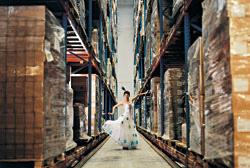
| HOME |
| NERVE |
| REVIEWS |
| ARCHIVE |
| EVENTS |
| LINKS |
| ABOUT US |
| CONTRIBUTORS |
| BACK ISSUES |
| CONTACT US |
 The Real
Thing: Contemporary Art from China
The Real
Thing: Contemporary Art from China
Tate Liverpool
30th March – 10th June 2007
Reviewed by Jennie Lewis
‘The Real Thing: Contemporary Art from China’ is attention-grabbing and thought-provoking in its introduction of the contemporary works of both esteemed artists and their recent protégés. At a time of unprecedented interest in a country facing major economic and social change, the exhibition allows us some insight into contemporary China today, and how recent cultural change gives way to prolific movement within the arts. This diverse collection illustrates the aptitude of some of China’s most established contemporary artists, and represents the height of ambition of the next generation.
Far removed from the highly decorative, traditional Chinese artwork, this particular exhibition reflects the current realm of unknown possibility and opportunity in terms of artistic approach. Advances within the country since the turn of the millennium, in the way of new media and technology, have allowed for a new and refreshing take on art, and the focus has shifted. Discarding mythological influences, artists now embrace a far more real and honest philosophy. With such changes came great global interest in the developing world of contemporary art in China.
Such realism bombards you the minute you enter the exhibition with the vision of Zhuang Hui’s ‘Factory Floor’, a large-scale reproduction of ‘The East is Red Tractor Factory’ where he once worked. Such striking precision in his craft, and the interpretation of everyday practice couldn’t fail to astound, and the isolated ambience instigated by evidence of ceased contact sets a somewhat haunting precedent. The suggestion of routine is continued as you move through the exhibition, meeting it’s pinnacle with the presentation of Geng Jiyanyi’s ‘An Unapologetic Act of Sabotage’. Comprised of video footage from hidden camera’s in Chinese spa, Jiyanyi explores everyday activities, often implemented on a sub-conscious level, that inevitably come to define us, and reinforces the idea of habit by means of one evocative sentence, simply ‘Goldfish swim in the pool.’ With this, Jiyanyi entices a level of reflection on our own personal identity.
As well as a personal voyage of exploration, the exhibition also serves as means of marking times of significant change in China, and none more so than Qui Zhijie’s ‘Railway from Lhasa to Kathmandu’, some homage to Nain Singh who played a vital role in the transformation of traditional China through his dedication to exploration on behalf of the British Survey. His journey reflects recent movements made to convert the country and propel it into the twenty-first century with the construction of many roads and railways, making China a more accessible country for future generations. However, this romanticised view on the modern world is not continued, and as you progress towards the end of the exhibition, so you see a more cynical outlook. Artists such as Yang Shaobin and Wang Gongxin underpin the anxieties many feel in this, such a rapidly changing society, and question the value of life in contemporary China.
Indeed some of the artists involved in the exhibition combat issues of weight and concern, from the inappropriateness of gender role reversal, to sexual confrontation, and even domestic violence. True to the ironic style that has, in many instances, come to characterise contemporary Chinese art, ideas are delivered by measures of dark, satirical humour. Though unexpected, and still reasonable unexplored through Western European art, the work of Zhou Xiaohu and Li Yongbin is refreshing and insightful.
‘The Real Thing: Contemporary Art from China’ is much coveted and lauded by its collaborators as one of the most powerful and important exhibitions today, as it showcases the sheer scale, range and ambition of many of the works and demonstrates the vivacity, energy and skill of contemporary Chinese artists.